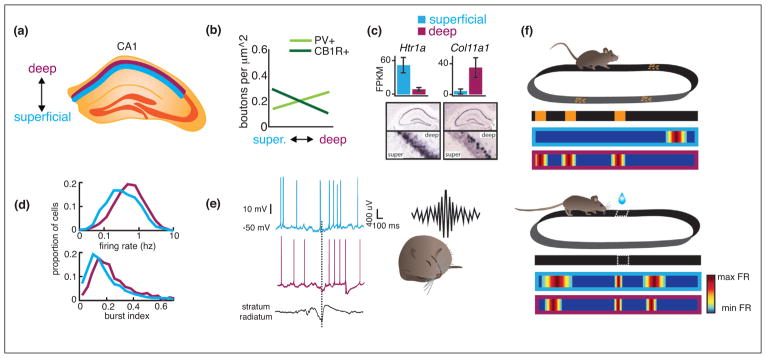Figure 2.
Place cells are a highly heterogeneous cell population. (a) Variation in place cell connectivity, gene expression, coding features and recruitment during behavior is observed across all axes of hippocampus. We focus here on the radial axis. Superficial (blue) and deep (purple) layers of CA1 are depicted in a coronal section of dorsal hippocampus. (b) In addition to differences in long-range inputs (shown in Figure 1b), perisomatic inhibition by different classes of basket cells varies across the radial axis. For example, innervation by parvalbumin positive (PV) interneurons is strongest within deep layers and decreases toward superficial layers. The opposite is true of cholecystokinin (CCK) positive interneurons, which most strongly innervate superficial layers. Data modified from [53•] with permission. (c) While gene expression varies most significantly across the dorsal–ventral axis of hippocampus, gradients are also observed across the radial axis. Shown are two examples of novel genes recently found to preferentially express in superficial (Htr1a) or deep (Col11a1) layers. FPKM: fragments per kilobase of exon per million fragments mapped. Data reproduced with permission from [30••]. (d) Basic firing characteristics including firing rate (top) and burst firing (bottom) differ between pyramidal neurons in superficial and deep layers. Data reproduced with permission from [56]. (e) Superficial and deep pyramidal neurons differentially participate in sharp-wave ripples: pyramidal neurons tend to be depolarized, while deep pyramidal neurons tend to by hyperpolarized. Data modified from [53•] with permission. (f) Superficial and deep pyramidal neurons show unique coding properties and play different roles in behavior. Top: Mice ran on a linear treadmill enriched with local cues. Superficial neurons were more prone to fire in a single, unique location across an environment, whereas a subpopulation of deep neurons encoded specific landmarks across multiple environments. Schematic modified from [55]. Bottom: Deep cells were more strongly impacted by an animal’s behavior on a task in which the mouse navigated to an unmarked location along a treadmill belt to receive reward [8••]. In both deep and superficial layers, place cells with fields located closer to the goal location were more spatially precise than those with fields located far from the goal, but this relationship was stronger amongst deep place cells. In addition, the stability of deep, but not superficial, place cells was increased across days when animals performed the attentional task (data not shown).

